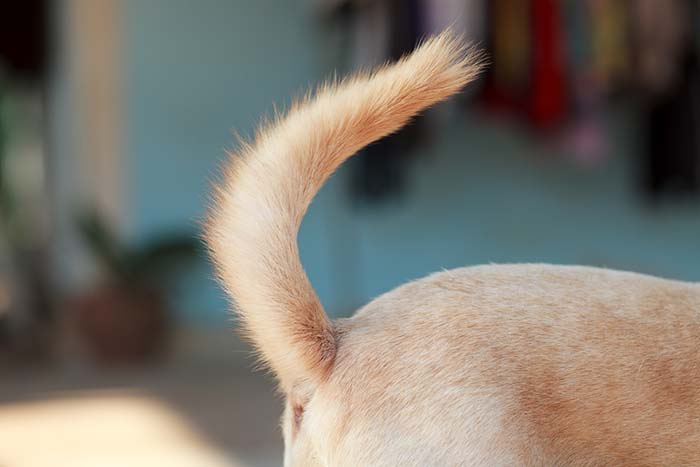A dog’s tail is one of the key tools he uses to communicate. If it’s not working properly, it can be painful and make things challenging for your dog. What is happy tail syndrome in dogs, and is it treatable?
In this guide, I’ll explain exactly what happy tail syndrome is, how it happens, and the different treatment options available.
Tail injuries in dogs can be difficult, and even frustrating, to deal with.
It’s hard to keep the tail still, and trying to stop your dog from wagging is like trying to keep the rain from falling.
We know that happy tail syndrome in dogs is an injury, so why do they call it happy tail, and what is it? Let’s take a look!
What Is Happy Tail Syndrome in Dogs?
and how to treat it

Most dogs have 20 vertebrae in their tail. Some breeds with shorter tails have less.
Happy tail syndrome in dogs occurs when they repeatedly forcefully hit their tail off solid objects.
This is where the name comes from. Happy dogs wag their tails, and this incessant wagging can sometimes lead to injury.
If your dog is an aggressive wagger, he may forcefully whack his tail into walls, furniture, table legs, or other objects.
When this happens, the thin skin on your pup’s tail will split, and you’ll likely notice blood splatters around the area.
You would think that an injury like this would stop your pet from wagging, but it won’t.
Your dog will keep wagging, which is what makes a happy tail so difficult to treat.
It also makes the condition especially painful for your dog because he’ll continue hitting his tail off of objects when it is injured.
If left untreated, your dog’s tail could become infected, leading to nerve damage. In extreme cases, the tail may need to be amputated.
Large breeds with skinny, powerful trails are most susceptible to this condition. Pitbulls, Great Danes, and Greyhounds may be more prone to developing happy tail syndrome, but any breed can develop a happy tail.
Obviously, breeds with shorter tails or curly tails are not very likely to develop this condition.
READ MORE: Dog Tail Docking – 5 Dangers of This Procedure According to Science

Symptoms
As I mentioned, you may notice blood splatters around your home on your pet’s bedding see that your pet’s tail is losing hair or cracked but hasn’t started bleeding yet.
In the beginning, Happy Tail won’t have any symptoms other than the visible signs of the condition.
If it’s not treated promptly, you may notice signs of infection such as lethargy, eating less, refusing to drink water, fever, and/or diarrhea.
If you notice any signs of infection, DO NOT try to treat Happy Tail at home. Consult your veterinarian right away, as your dog may need antibiotics or other medical care.
Treatment
You can try to treat the injury by cleaning and wrapping the wound.
It’s important to keep your dog as quiet as possible so he doesn’t risk hitting his tail again.
If you cannot treat the injury quickly, it is likely to become infected.
Your dog’s tail is close to his rear end. This means it may touch the ground, feces, or urine when he goes to the bathroom.
An open wound in this area is just asking for trouble.
This is why it’s important to seek veterinary care as soon as you realize that your dog has happy tail syndrome.
If infection has already set in or your dog suffers from this condition on a regular basis, your vet may recommend tail amputation.
If they decide to treat the condition instead, they will probably prescribe a few different medications.
Anti-inflammatories, antibiotics, and pain medications may all be part of your pet’s treatment regimen.
He may also need a sedative for a few days to ensure his tail stays calm.
Tail slings are also helpful when your pet is diagnosed with happy tail syndrome. They are a brace that keeps the tail still while also covering it with a sleeve to protect the injury.
If the injury is in a place that can be treated and covered, you should also fit your dog with an e-collar to prevent him from liking off ointment or chewing off any coverings.
Keep a close eye on the injury, and seek advice from your veterinarian if you have any cause for concern.
READ NEXT: 25 Dog Health Symptoms That You Must Address Right Away












